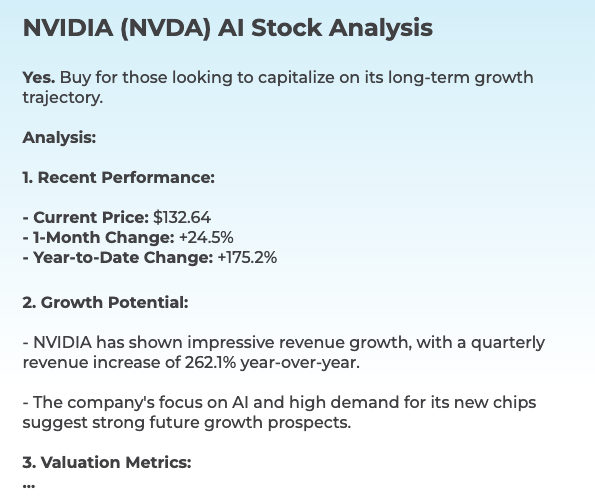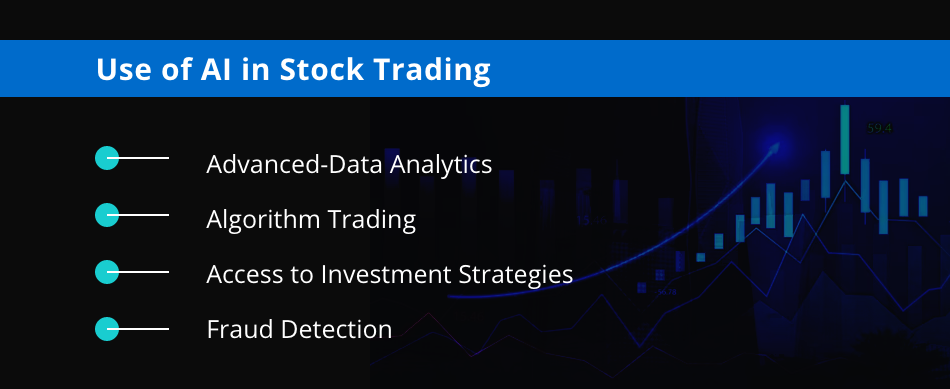20 Best News For Picking AI Stock Predictions Platform Websites
20 Best News For Picking AI Stock Predictions Platform Websites
Blog Article
Top 10 Tips When Considering Ai And Machine Learning Models On Ai Stock Trading Platforms
It is essential to examine the AI and Machine Learning (ML) models used by trading and stock prediction systems. This will ensure that they provide accurate, reliable and actionable insights. Poorly designed or overhyped models could lead to inaccurate predictions or even financial losses. Here are the 10 best tips for evaluating AI/ML models for these platforms.
1. Understand the Model's Purpose and Method of Approach
Clarified objective: Determine the objective of the model and determine if it's intended used for trading on short notice, investing long term, sentimental analysis or managing risk.
Algorithm Transparency: Verify if the platform reveals what kinds of algorithms are employed (e.g. regression, decision trees neural networks or reinforcement-learning).
Customizability. Determine if the model is able to be modified according to your trading strategy or the level of risk tolerance.
2. Perform an analysis of the model's performance indicators
Accuracy. Find out the model's ability to forecast, but do not rely on it alone, as this can be inaccurate.
Precision and recall: Assess the accuracy of the model to discern real positives, e.g. correctly predicted price changes.
Risk-adjusted return: Examine if the model's predictions lead to profitable trades after accounting for risk (e.g., Sharpe ratio, Sortino ratio).
3. Test the Model by Backtesting it
Performance historical Test the model by using historical data to check how it performs in previous market conditions.
Examine the model using information that it hasn't been taught on. This will help to stop overfitting.
Scenario-based analysis involves testing the accuracy of the model in various market conditions.
4. Make sure you check for overfitting
Overfitting Signs: Look out for models which perform exceptionally well when trained but poorly with data that is not trained.
Regularization methods: Determine whether the platform uses techniques like L1/L2 normalization or dropout to prevent overfitting.
Cross-validation. Ensure the platform performs cross validation to test the generalizability of the model.
5. Review Feature Engineering
Relevant Features: Look to see whether the model includes meaningful characteristics. (e.g. volume, technical indicators, prices and sentiment data).
Select features with care Make sure that the platform will include statistically significant data and not irrelevant or redundant ones.
Dynamic updates of features: Check to see how the model adapts itself to the latest features or changes in the market.
6. Evaluate Model Explainability
Interpretability - Make sure that the model offers explanations (e.g. values of SHAP or the importance of a feature) for its predictions.
Black-box model Beware of platforms that use models that are too complicated (e.g. deep neural networks) without describing the the tools.
User-friendly insights: Make sure that the platform provides actionable insights in a form that traders are able to comprehend and use.
7. Check the adaptability of your model
Market changes: Determine whether the model can adjust to changing market conditions, for example economic shifts and black swans.
Continuous learning: Ensure that the platform updates the model with fresh information to enhance performance.
Feedback loops: Ensure the platform is incorporating feedback from users or actual results to improve the model.
8. Check for Bias or Fairness.
Data bias: Ensure that the training data is representative of the market and free from biases (e.g., overrepresentation of certain areas or time frames).
Model bias: Determine if are able to monitor and minimize biases that are present in the forecasts of the model.
Fairness: Check whether the model favors or not favor certain types of stocks, trading styles or even specific sectors.
9. Calculate Computational Efficient
Speed: Evaluate whether you can predict using the model in real-time.
Scalability: Check whether the platform can manage many users and huge data sets without affecting performance.
Utilization of resources: Determine if the model is optimized for the use of computational resources effectively (e.g. use of GPU/TPU).
Review Transparency and Accountability
Model documentation - Make sure that the model's documentation is complete information about the model, including its structure the training process, its limitations.
Third-party auditors: Make sure to see if the model has been subject to an independent audit or validation by an independent third party.
Error Handling: Verify whether the platform contains mechanisms that detect and correct errors in models or failures.
Bonus Tips
User reviews Conduct user research and conduct cases studies to evaluate the effectiveness of a model in real life.
Free trial period: Test the accuracy of the model and its predictability with a demo, or a no-cost trial.
Support for customers: Make sure whether the platform offers robust customer support to help resolve any technical or product-related issues.
Check these points to evaluate AI and ML models for stock prediction, ensuring that they are reliable and transparent, as well as compatible with trading goals. View the top click this link about using ai to trade stocks for site examples including ai stock trading app, incite, ai trade, stock ai, best ai stock trading bot free, best ai for trading, ai investing app, best ai for trading, chart ai trading assistant, ai for stock trading and more.
Top 10 Tips To Assess The Scalability Ai Stock Predicting/Analyzing Trading Platforms
Scalability is an important factor in determining whether AI-driven platforms for stock prediction and trading are able to handle growing demand from users, increasing markets and data volumes. These are the top 10 tips to determine scalability
1. Evaluate Data Handling Capacity
TIP: Ensure that the platform you are using is able to process and analyze huge datasets.
The reason: Scalable platforms must be able to handle increasing data volumes without performance degradation.
2. Test real-time processing capabilities
Find out how the platform handles real-time streams of data, including price movements and breaking news.
The reason is that real-time trading decisions require analysis of data in real-time. In the event of delays, it could result in missed opportunities.
3. Cloud Infrastructure Elasticity and Check
Tips: Determine whether the platform is able to dynamically scale resources and uses cloud infrastructure (e.g. AWS Cloud, Google Cloud, Azure).
Cloud-based platforms are a great way to gain elasticity. They permit the system to scale up or down according to demand.
4. Algorithm Efficiency
Tip: Assess the efficacy of AI models used to make predictions (e.g. Deep Learning or Reinforcement learning).
What is the reason? Complex algorithms may require a lot of resources. Optimizing them to ensure they are scalable is essential.
5. Study distributed computing and parallel processing
Tips: Check whether the platform is using parallel processing frameworks or distributed computing frameworks.
Why: These technologies allow more efficient data processing and analytics across many nodes.
Examine API Integration & Interoperability
Test the platform’s integration capabilities with APIs that are external to the platform.
What's the reason? Seamless integration guarantees that the platform is able to adapt to the latest information sources and environments for trading.
7. Analyze User Load Handling
To check the performance of your system, simulate high-traffic.
The reason: Performance of a platform that is scalable is not affected by the growth in users.
8. Examine the model's retraining capabilities and the model's adaptability
Tip: Assess how frequently and efficiently the AI models are trained with new data.
Why? Models have to constantly adapt to the changing market in order to remain accurate.
9. Check for Fault Tolerance and Redundancy
TIP: Make sure the platform has failover mechanisms, and has redundancy in the event of software or hardware failures.
What's the reason? Trading downtime can be costly, so the ability to tolerate faults is essential for scalability.
10. Monitor Cost Efficiency
TIP: Take into consideration the cost of scaling up your platform. Consider cloud resources, such as data storage and computing power.
Why is it important to maintain a healthy equilibrium between the performance costs and expenses.
Bonus tip Future-proofing
ensuring that the platform will be able to adapt to new technology (e.g. advanced NLP, quantum computing) as well as regulatory changes.
By focusing your focus on these aspects it is possible to accurately evaluate the scale of AI prediction and trading platforms. This will ensure that they are durable and efficient and ready for further expansion. Follow the best find out more for trading ai tool for blog examples including ai for trading stocks, ai share trading, ai stock price prediction, ai options, trading ai tool, ai stock predictions, invest ai, best ai penny stocks, ai copyright signals, chart ai trading and more.